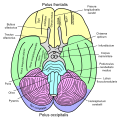Pituitary stalk
Pituitary Stalk
The Pituitary Stalk also known as the infundibulum or hypophyseal stalk, is a thin piece of tissue that connects the hypothalamus to the pituitary gland. It plays a crucial role in the endocrine system, facilitating the transport of hormones from the hypothalamus to the pituitary gland.
Structure[edit]
The pituitary stalk is a slender, tubular structure that extends downward from the hypothalamus, a region of the brain that controls many bodily functions. The stalk connects the hypothalamus to the pituitary gland, which is located at the base of the brain. The pituitary gland is divided into two parts: the anterior pituitary and the posterior pituitary, both of which are connected to the hypothalamus by the pituitary stalk.
Function[edit]
The primary function of the pituitary stalk is to transport hormones from the hypothalamus to the pituitary gland. These hormones include thyrotropin-releasing hormone (TRH), corticotropin-releasing hormone (CRH), gonadotropin-releasing hormone (GnRH), growth hormone-releasing hormone (GHRH), and somatostatin.
Once these hormones reach the pituitary gland, they stimulate the gland to produce and release its own hormones, which then travel through the bloodstream to target organs throughout the body. These hormones regulate a wide range of bodily functions, including growth, metabolism, reproduction, and stress response.
Clinical significance[edit]
Damage to the pituitary stalk can lead to a variety of medical conditions. For example, a pituitary tumor can compress the stalk, disrupting hormone transport and leading to symptoms such as hypopituitarism, a condition characterized by reduced hormone production by the pituitary gland. Other conditions that can affect the pituitary stalk include diabetes insipidus, hyperprolactinemia, and empty sella syndrome.
See also[edit]
Ad. Transform your life with W8MD's Budget GLP-1 injections from $75


W8MD offers a medical weight loss program to lose weight in Philadelphia. Our physician-supervised medical weight loss provides:
- Weight loss injections in NYC (generic and brand names):
- Zepbound / Mounjaro, Wegovy / Ozempic, Saxenda
- Most insurances accepted or discounted self-pay rates. We will obtain insurance prior authorizations if needed.
- Generic GLP1 weight loss injections from $75 for the starting dose.
- Also offer prescription weight loss medications including Phentermine, Qsymia, Diethylpropion, Contrave etc.
NYC weight loss doctor appointmentsNYC weight loss doctor appointments
Start your NYC weight loss journey today at our NYC medical weight loss and Philadelphia medical weight loss clinics.
- Call 718-946-5500 to lose weight in NYC or for medical weight loss in Philadelphia 215-676-2334.
- Tags:NYC medical weight loss, Philadelphia lose weight Zepbound NYC, Budget GLP1 weight loss injections, Wegovy Philadelphia, Wegovy NYC, Philadelphia medical weight loss, Brookly weight loss and Wegovy NYC
|
WikiMD's Wellness Encyclopedia |
| Let Food Be Thy Medicine Medicine Thy Food - Hippocrates |
Medical Disclaimer: WikiMD is not a substitute for professional medical advice. The information on WikiMD is provided as an information resource only, may be incorrect, outdated or misleading, and is not to be used or relied on for any diagnostic or treatment purposes. Please consult your health care provider before making any healthcare decisions or for guidance about a specific medical condition. WikiMD expressly disclaims responsibility, and shall have no liability, for any damages, loss, injury, or liability whatsoever suffered as a result of your reliance on the information contained in this site. By visiting this site you agree to the foregoing terms and conditions, which may from time to time be changed or supplemented by WikiMD. If you do not agree to the foregoing terms and conditions, you should not enter or use this site. See full disclaimer.
Credits:Most images are courtesy of Wikimedia commons, and templates, categories Wikipedia, licensed under CC BY SA or similar.
Translate this page: - East Asian
中文,
日本,
한국어,
South Asian
हिन्दी,
தமிழ்,
తెలుగు,
Urdu,
ಕನ್ನಡ,
Southeast Asian
Indonesian,
Vietnamese,
Thai,
မြန်မာဘာသာ,
বাংলা
European
español,
Deutsch,
français,
Greek,
português do Brasil,
polski,
română,
русский,
Nederlands,
norsk,
svenska,
suomi,
Italian
Middle Eastern & African
عربى,
Turkish,
Persian,
Hebrew,
Afrikaans,
isiZulu,
Kiswahili,
Other
Bulgarian,
Hungarian,
Czech,
Swedish,
മലയാളം,
मराठी,
ਪੰਜਾਬੀ,
ગુજરાતી,
Portuguese,
Ukrainian





